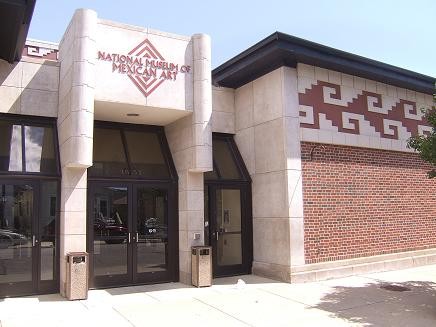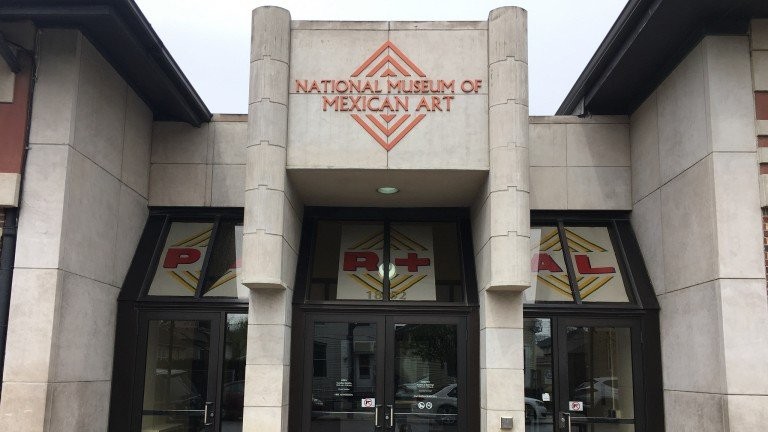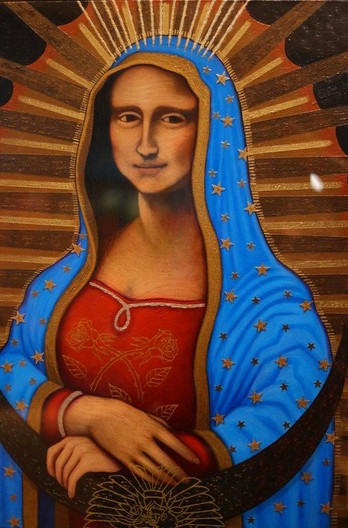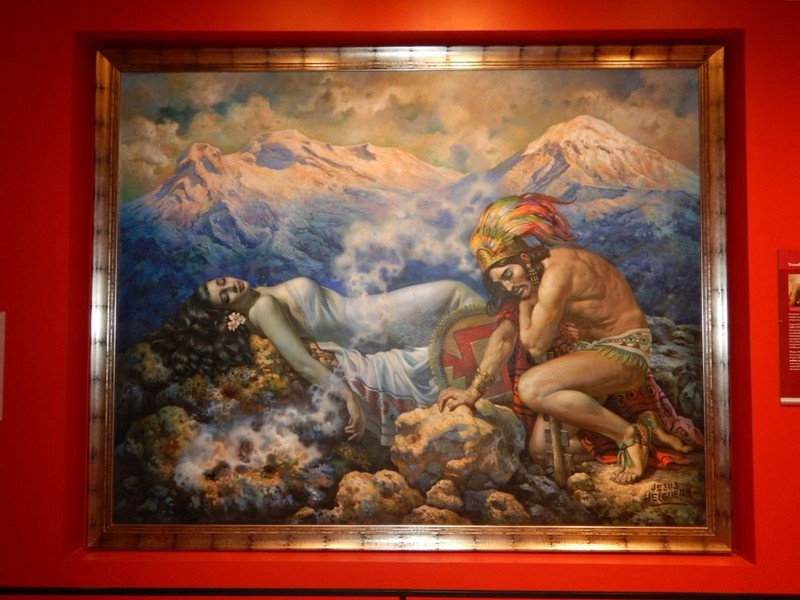National Museum of Mexican Art
Introduction
Text-to-speech Audio
Images
The National Museum of Mexican Art is the only museum of its kind to be accredited by the American Alliance of Museums.

The National Museum of Mexican Art, located at 1852 W 19th St. in Pilsen, founded in 1987 by Carlos Tortolero

Cesar Augusto Martinez: Mona Lupe 1975 (featured in the museum’s permanent exhibit)

Jesús Helguera’s 1940 painting La Leyenda de los Volcanes, featured in the Pre-Cuauhtémoc section of the museum’s permanent collection

Backstory and Context
Text-to-speech Audio
Prior to the opening of the Mexican Fine Arts Center, there were no other institutions that focused primarily on Mexican art and culture. Founder Carlos Tortolero wanted to change that by establishing an accessible arts and cultural organization. In 1982 and only $900, he organized a team of fellow teachers and community activists to help design the museum. After five years of intense planning, the museum debuted under the name Mexican Fine Arts Center in 1987. Its inaugural exhibition Images of Faith: Religious Art of Mexico in the 18th and 19th Centuries showed the essential role that religion played in the interactions between Spanish missionaries and the Indians in Mexico1. The exhibit filled the longstanding Chicano-sized hole in the community. Having an exhibit specific to Mexican history was a large and much-needed step to gain respect for Mexican culture. Tortolero’s initiative helped others and even those within the Mexican community to appreciate the beauty of Mexican culture instead of letting it languish.
Initially, Tortolero received some pushback when he said that he wanted the museum to be located in the working-class neighborhood Pilsen. All of his peers believed that starting an arts museum in a blue-collar neighborhood was “crazy”, not to mention problems with funding if admission was free. Tortolero was told “it couldn’t be done”2. Tortolero disregarded these warnings, because he had a vision in mind. The aspects that others criticized worked out to be the strengths of the museum. Pilsen’s charm and free admission made the museum accessible and today the expansion of the neighborhood with new restaurants popping up nearby only make it more alluring. Also, outside the museum are the famous Pilsen murals that decorate the neighborhood.
In order to support its growth, the Mexican Fine Arts Center moved to a 48,000 square foot state of the art facility in 2001. In 2006, the museum was rebranded to the name it has today, the National Museum of Mexican Art. The change in name was to reflect the evolution of the museum into a nationally recognized institution, especially because the museum remains the only Mexican museum accredited by the American Alliance of Museums.
In 2014, the museum revamped their permanent collection. The new exhibit, Nuestras Historias, is filled with new art pieces from over 160 different artists. The curator, Cesar Moreno, stated that the “best of [their] collection is on display.” The transformation of the past collection to Nuestras Historias truly is a highlight of the museum because while the pieces are extraordinarily beautiful, they also capture the history and narratives behind Mexican culture.
The works of art focus on the identity of Mexican peoples over the years, capturing the diverse stories of Mexican individuals. The exhibit portrays Mexican identity as an idea that continually evolves over time, something that could not be encompassed by a singular concept or artist. This aspect of the museum is a pillar for Mexican society because it allows for individuals not familiar with Mexican culture to recognize the multiple, complex identities within Mexican communities.
Each work of art in the Pre-Cuauhtémoc section of the permanent collection represents an important aspect of ancient Mexican history and culture. The term “Pre-Cuauhtémoc” was frequented by Tortolero, who intended to de-emphasize the Eurocentric view of Mexican history. The museum places an importance on displaying all past Mexican interactions, even those that may prove difficult or complex, such as Spanish colonization and the Mexican revolution. All of the older art pieces are located in the indigenous wing of the museum, and as a result, each work of art plays an important role in depicting the historical and cultural context of the museum. One of the most influential pieces in the collection is Jesús Helguera’s 1940 painting La Leyenda de los Volcanes, depicting the legend of Popocatepetl and Iztaccihuatl. The painting is integral to ancient Mexican culture, as the story of Popo and Ixta has been passed down from generation to generation for centuries between Mexican families. The permanent collection transitions from ancient Mexican culture to Mexican history in which Enrique Alférez’s artwork is commonplace. Alférez has twelve sculptures throughout the museum, most prominently located in an exhibit in the permanent collection titled “Arte Diseño Xicágo.” This exhibit focuses on art from the time period between the World’s Columbian Exposition in 1893 and the Civil Rights Era, which concluded in the early 1970s. Perhaps the most distinguished work of art in the exhibit is Alférez’s sculpture titled La Soldadera. La Soldadera contributes greatly to the indigenous wing of the permanent collection, tying together the exhibit with the enriching Mexican history associated with the Mexican Revolution, which allowed Mexicans to feel a strong sense of independence and freedom for the first time in their lives. Also included in the museum is world-renowned painter Diego Rivera. Rivera played a significant role in the expansion of Mexican art globally, helping to establish the Mexican mural movement. Rivera’s presence in the National Museum of Mexican Art conveys the museum’s commitment to exhibiting artists and works in the indigenous wing that prove meaningful in displaying the notable history and culture of Mexico’s past.
Many of the more modern pieces at the museum target contemporary political issues. Ranging from subtle to defiant, these art pieces challenge the status quo and unify Mexican and Mexican-American communities, past and present. Pieces such as Liberating Borders by Hector Duarte help exemplify the difficulties of Mexican immigrants coming to America and the racism that they face. The museum also holds pieces that are integral to Mexican political identity. In the Galeria Cardenas subwing, The Grapes of Wrath Poster exemplifies the Delano Grape Strike and boycott that many Mexican workers participated in to secure better working conditions and better wages. The museum also holds pieces that are significant to the museum’s history such as the jacket that Cesar Chavez wore at his last time to the museum. These pieces takes museum goers back to the past, especially the civil rights movements of the 60’s and 70’s. Three sculptures from the Deportable Alien Series showcase some of these hardships by representing the unfair repatriation under the Hoover and Roosevelt administrations. By keeping these pieces of work in their permanent gallery, the museum pays tribute to past generations whose perseverance created a better future for those today.
The museum hosts all sorts of cultural programs such as symposiums and theater/music/dance performances. The museum also celebrates their annual Sor Juana Festival which pays homage to accomplishments of Mexican women. The festival honors Sor Juana Inés de la Cruz, a 17th century Mexican nun who fought for equal rights in women’s education. The Sor Juana Festival places an emphasis on the importance of Mexican women in the art industry. Each year, the festival hosts a number of talented Mexican or Mexican-American female artists. Another annual event that the museum hosts is the Dia de los Muertos: Love Never Dies Ball. This dancing escapade honors the lives of those who have passed before us with live Mexican music, cuisine, and cocktails. The event shows a deep reverence for Mexican history and culture, a fundamental principle on which the museum was founded. The National Museum of Mexican Art continually hosts events in order to promote Mexican culture and praise the accomplishments of Mexican individuals.
In 2017, the museum celebrated its 30th anniversary with a new exhibit Memoria Presente: An Artistic Journey. Thiry Mexican artists, including famous names Alberto Aguilar, Maria Gaspar, and Juan Angel Chavez, were invited to furnish the museum with wild yet still politically charged instillations. The pieces cover the complexities of immigration, the ramifications of drug cartels, and the violence in Mexican-American communities. Despite the celebration, the museum used its anniversary as a platform to bring much needed attention to these controversial topics.
While the museum acquires its own art pieces, it flourishes because of support from the community. In 2005, the museum was able to run an exhibit purely from pieces borrowed from local collectors. The exhibit, Colecciones: Mexican Art from 50 Private Chicago Collections, featured 110 loaned pieces of art. Individuals such as Scott Hodes, a local Chicago attorney, and Gilberto Cárdenas, Executive Director of the Notre Dame Center for Arts and Culture, willingly lent their prized pieces to the museum3. Cardenas eventually had a wing of the permanent collection named after him. Cesar Moreno, curator of the museum, found that instead of having to track down local collectors, they would freely volunteer their help. In addition, because admission is free, the museum relies on donations and grants to run daily operations and events. Some major contributors include the Anheuser-Busch, Southwest Airlines, Boeing, and JP Morgan Chase. They allow for the museum to stand as a monument of Mexican culture. In 2018, the National Museum of Mexican Art received another 5-year commitment award of $300,000 from the MacArthur Foundation because of its devotion to the community and its goal of developing appreciation for Mexican culture. Because of all these donations, the museum is able to achieve its goals of preserving Mexican art and culture, developing Mexican artists, and providing an arts education to local Chicago neighborhoods. The museum receives over 165,000 annual visitors, including nearly 60,000 K-12 students, who appreciate the beautiful exhibits on display and take part in the numerous cultural and artistic activities.
Sources
Nuestras Historias. National Museum of Mexican Art. . Accessed May 31, 2019. http://nationalmuseumofmexicanart.org/exhibits/nuestras-historias.
Johnson, Steve. National Museum of Mexican Art: A vibrant scene in Pilsen. Chicago Tribune. January 21, 2015. Accessed June 10, 2019. https://www.chicagotribune.com/entertainment/museums/ct-ent-0122-national-museum-mexican-art-20150121-column.html. (Footnote 2)
Carde, Leslie. The Advocate. March 25, 2019. Accessed May 27, 2019. https://www.theadvocate.com/new_orleans/article_9963e6c4-2e26-11e8-998e-2772b8aa27e3.html.
National Museum of Mexican Art. . Accessed May 20, 2019. http://nationalmuseumofmexicanart.org/content/about-us-0.
Wecker, Menachem. At Chicago museum, Mexican Catholic History emerges. NCR Online. . Accessed June 07, 2019. https://www.ncronline.org/news/media/chicago-museum-mexican-catholic-history-emerges.
Pridmore, Jay. Mexican Fine Arts Center Debuts With A Saintly Show. Chicago Tribune. April 10, 1987. Accessed June 10, 2019. https://www.chicagotribune.com/news/ct-xpm-1987-04-10-8701270532-story.html.
Waxman, Lori. National Museum of Mexican Art celebrates its 30th with a protest party. Chicago Tribune. July 05, 2017. Accessed June 10, 2019. https://www.chicagotribune.com/entertainment/museums/ct-nmma-anniversary-review-ent-0706-20170705-story.html.
Goddu, Jenn Q.. Local art collectors share their Mexican rarities. Chicago Tribune. May 13, 2005. Accessed June 11, 2019. https://www.chicagotribune.com/news/ct-xpm-2005-05-13-0505130216-story.html. (Footnote 3)
